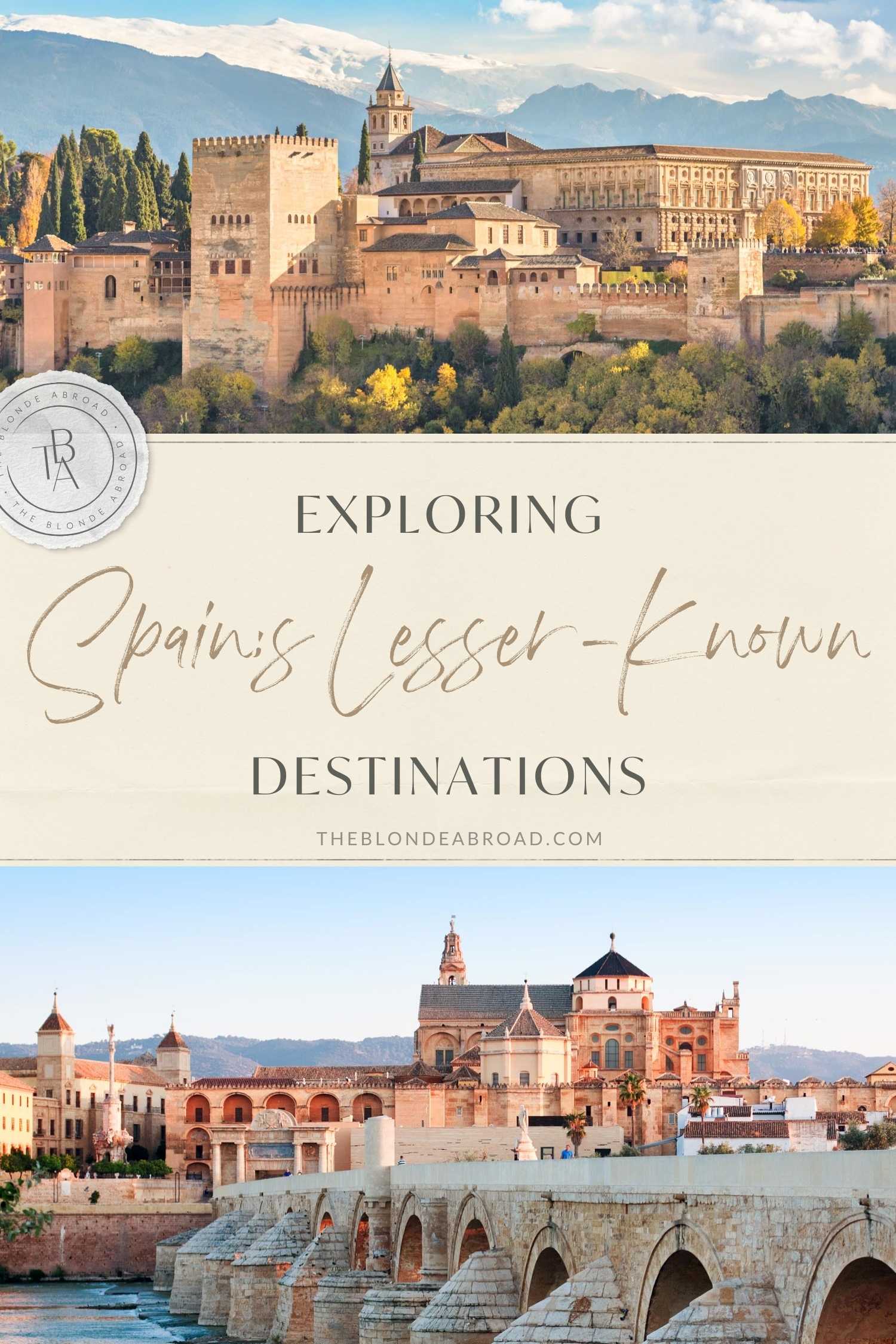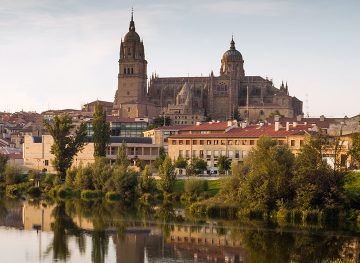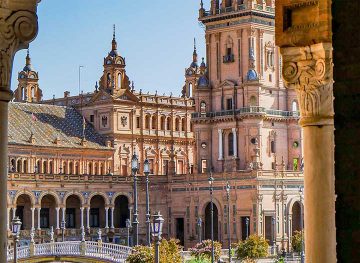Spain will always hold a special place in my heart. It was the destination of my first international trip, and where I studied Spanish abroad and started to discover how much excitement the world had to offer.
My favorite part of that first trip was able to explore smaller cities and towns in Spain that I wouldn’t have known about prior, and that are somewhat off the tourist path. I spent a month in Spain that summer, living in Salamanca and El Puerto de Santa Maria, and exploring the surrounding regions.
Here are some of Spain’s lesser-known destinations!
Castile and León Region
Segovia
From Madrid, you can get to the city of Segovia in less than thirty minutes on the high-speed train, and I recommend getting out there. Famous for its Alcázar and Roman aqueduct, Segovia is a gorgeous UNESCO World Heritage Site.
One thing that I found interesting about Segovia is that it’s said that Walt Disney drew inspiration from the majestic Alcázar for the iconic Cinderella’s castle.
Helpful Tip: You can buy train tickets online with your Mastercard credit card on the Renfe website. You have the options to grab a Renfe Spain pass to explore the entire country or to get roundtrip tickets as you need them; both can be good options depending on your plans.
Ávila
If you’re planning to visit Madrid, don’t miss Ávila. You can travel between the cities in less than two hours by Renfe train, and it’s well worth the trip.
Ávila is a World Heritage monument, one of the oldest cities in Spain and considered a “City of Three Cultures” (Jewish, Islamic and Christian). Most notably, it’s the birthplace of Santa Teresa and a stop along the Camino de la Lengua, a historical route that hits various places that influenced the development of Spanish culture and language.
Salamanca
The north of Spain is completely underrated. While the south is gorgeous, the north has a unique look and feel that you have to see.
When I studied abroad in 2008, I spent my first two weeks in the city of Salamanca and absolutely loved it. It’s a fun college town with a remarkable history, and the people are among the friendliest you’ll ever meet.
Read More: A Photo Tour of Salamanca, Spain
Asturias Region
Covadonga
A mountainous region on the northern coast of Spain, Asturias is unlike anywhere else in Spain. The locals take immense pride in the fact that they have always been Spanish. Asturias is the only part of Spain that was never conquered by the Moors, so on top of being stunning, the region is distinct in several ways.
The village of Covadonga in Asturias is an absolute must-see. It’s a historically significant spot where the Reconquista of Spain began. It’s also home to one of the very few Spanish lakes and the picturesque San Fernando Collegiate Church.
Helpful Tip: Like in most villages, there are some small cash-only businesses around Asturias. Use your Mastercard to withdraw cash at the start of your adventure, so you’re covered.
Extremadura Region
Mérida
Once a far-flung Roman capital, Mérida is home to 60,000 residents, incredible ruins, and an amazing Roman Theater that’s still in use. Halfway between Madrid and Seville, near the Portuguese border, this city is too often overlooked.
While you may have never heard of it, Mérida is one of the most beautiful spots in Spain, and you’ll find tons to do there.
Cáceres
The quaint city of Cáceres is just an hour from Mérida. Stroll the cobblestone streets, and take in the incredible architecture while learning about the city’s rich history. As an added perk, you can save some serious euros here. Cáceres has the lowest cost of living in all of Spain, and you’ll find bargains all over the city.
Helpful Tip: Cáceres has a lot of smaller shops and restaurants alongside chains, so it’s handy to have cash!
Andalusia Region
Córdoba
You can’t visit Spain without checking out the Andalusia region. Córdoba is a lesser-known town in the area, but having played an important role in both the Roman Empire and the Moorish period, this place has a fascinating history and breathing-taking sites.
For me, the highlight of Córdoba is la Mezquita (Catedral de Córdoba), one of the largest and most symbolic Islamic buildings in the world. It was built in the Umayyad dynasty when Islam reigned over Spain but then was converted into a cathedral after the Reconquista or the Spanish Conquest by the Christians.
Málaga
The second largest city in the Andalusia region, Málaga is an ideal hub for travelers. The town is over 2,800 years old, making it one of the oldest cities in the world– it is rapidly developing, but has maintained its picturesque charm. The Castle of Gibralfaro, which is connected to the Alcazaba, is one of the main historical sights.
The art and cultural scene is on the rise and is being compared to Madrid in that sense.
You’ll find lots of fine dining has rapidly emerged as the province’s city of culture with its so-called ‘mile of art’ being compared to Madrid, and its dynamism and fine dining to Barcelona.
Discount airlines like Ryanair and EasyJet fly into Málaga, so you can city hop on the cheap. Europe is full of discount airlines, and they’re perfect for short trips. The rates are ultra-competitive, and they are totally no-frills.
Helpful Tip: I recommend using a Mastercard credit card that offers travel miles. Even if you don’t travel a ton, the points build up quickly. I especially love it because it means that I don’t have to be loyal to any particular airline, and can go with the most affordable option on a trip-by-trip basis. Especially in Europe, you can save a lot of cash by booking with the discount airlines, and those airlines rarely offer miles or points.
Granada
If I had to make a top-ten list of Europe’s best sites, the Alhambra of Granada would absolutely make the cut. Overlooking the city, this fortress is one of Spain’s most popular destinations.
When visiting Granada, the Alhambra is an absolute must visit, but because of its popularity, you need to book early. But, Andalusia is also the birthplace of Flamenco, so I’d highly recommend planning to see a show while you’re there. Avoid a group tour, and find a private Flamenco club.
Helpful Tip: Before you head to Granada, get online. If you book your Alhambra tickets with your Mastercard credit card on the Spanish Ticketmaster site, you can avoid the lines and ensure your spot at this UNESCO World Heritage site.
Read More: 25 Destinations To Visit in Your Lifetime
If you want to discover more hidden treasures in Europe, follow #tophiddentreasures or check out Mastercard’s compilation about the Top Hidden Treasures in Europe.
This post was written in partnership with Mastercard. As always, thoughts and opinions expressed here are entirely my own.


















Thanks for sharing! This is seriously a trip of a lifetime. I hope to make it someday soon!
I’m dying to make it to Granada and the Asturias Region – that church is gorgeous and reminds me a bit of the Alsace region as well!